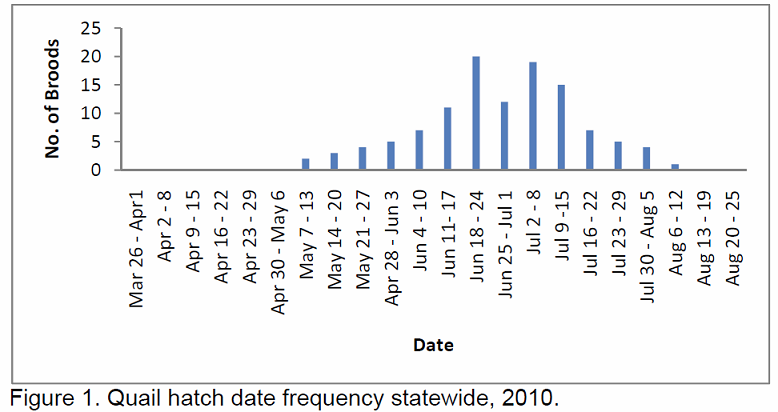Woke up to the national news this morning talking about some flooding going on in some parts of the State. Up to 4" of rain. My question is: At what nesting stage are the Quail in right now for mid-may in KS. Shouldn't they be laying eggs right about now with the peak of the hatch in mid June?
You are using an out of date browser. It may not display this or other websites correctly.
You should upgrade or use an alternative browser.
You should upgrade or use an alternative browser.
Ks Flooding
- Thread starter Bamaquail
- Start date
Seems this comes up nearly every year. While I would never pretend to have the knowledge our own Prairie Drifter, I try very hard to study the habits, traits, and needs of the game we love. What's attached may seem a bit extreme, but it's the type of data I collect to help me learn more about upland game.
The chart below is from 2010. While the curve is somewhat average for quail, it is not truly normally distributed (for 2010). If you were to take the data for each year and overlay it on this type of chart, you would find the hatch curve to be normally distributed with the peak of the hatch (in Kansas) roughly on Father's day.

Source KDWP - 2011
A few of things to note:
1) Although rare, a few quail hatched as early as May 7 - 13
2) Incubation period is roughly 23 days. This means that nesting occurs not only before the hatch, but significantly before the hatch. Let's say a hen lays an average of 13 eggs at a rate of 1 per day; this means that nesting must occur a minimum of 36 days before the hatch (13 + 26). In all likelihood, nesting begins earlier than 36 days before the hatch (at least at this time of year).
3) The period of June 25 - July 1 in the chart above is an anomaly. Something happened during that period (or well before) that slowed/hampered nesting. This may be explained by a significant or widespread weather event which forced renesting, the need for the hen to start over, or delayed the nesting cycle for a large portion of the survey area.
Well, I guess that settles it, I'm a complete dork!!
Prairie Drifter, care to weigh in and let us know how it really works?
Point!
The chart below is from 2010. While the curve is somewhat average for quail, it is not truly normally distributed (for 2010). If you were to take the data for each year and overlay it on this type of chart, you would find the hatch curve to be normally distributed with the peak of the hatch (in Kansas) roughly on Father's day.

Source KDWP - 2011
A few of things to note:
1) Although rare, a few quail hatched as early as May 7 - 13
2) Incubation period is roughly 23 days. This means that nesting occurs not only before the hatch, but significantly before the hatch. Let's say a hen lays an average of 13 eggs at a rate of 1 per day; this means that nesting must occur a minimum of 36 days before the hatch (13 + 26). In all likelihood, nesting begins earlier than 36 days before the hatch (at least at this time of year).
3) The period of June 25 - July 1 in the chart above is an anomaly. Something happened during that period (or well before) that slowed/hampered nesting. This may be explained by a significant or widespread weather event which forced renesting, the need for the hen to start over, or delayed the nesting cycle for a large portion of the survey area.
Well, I guess that settles it, I'm a complete dork!!
Prairie Drifter, care to weigh in and let us know how it really works?
Point!
Last edited:
1pheas4
Moderator
Well, I guess that settles it, I'm a complete dork!!
LOL....Nah. You fit in well around here.:cheers:
Nice post Point.
Nick
According to Weatherbell and Accuweather a moderate to strong El Nino has already started. Most of the moisture from the storms that is carrying in the needed good rains to the plains over the last month originated in the south pacific, not in the Gulf of Mexico. This should continue all summer.
If we go back and look at the past strong/moderate El Nino years like 1982-1983, 2002-2003, 2004-2005 and 2006-2007 and compare them to the quail and pheasant hatch, you will notice and big increase in the fall bird population.
Rain is always better than drought and heat (remember the summer of 2011). Even a little flood will drain off in a day or so and the wild bird will go back to the nest. I once found a wild quail nest and it was built up off the ground.
Rain water from the heavens (not irrigation water) is full of microscopic minerals ions and nitrogen and is loaded with nutrients that leads to healthy green and nutritious vegetation for the quail and pheasants to eat. The green vegetation is like natural laying mess.
The birds start off with a higher number of healthy eggs. And the chicks that hatch have an abundance of fat juice insects and cover for protection from predator and shade from the summer heat. The result is greater number of chicks that grow fast with the greater moisture and nutrients and greater survival to adult birds.
If we go back and look at the past strong/moderate El Nino years like 1982-1983, 2002-2003, 2004-2005 and 2006-2007 and compare them to the quail and pheasant hatch, you will notice and big increase in the fall bird population.
Rain is always better than drought and heat (remember the summer of 2011). Even a little flood will drain off in a day or so and the wild bird will go back to the nest. I once found a wild quail nest and it was built up off the ground.
Rain water from the heavens (not irrigation water) is full of microscopic minerals ions and nitrogen and is loaded with nutrients that leads to healthy green and nutritious vegetation for the quail and pheasants to eat. The green vegetation is like natural laying mess.
The birds start off with a higher number of healthy eggs. And the chicks that hatch have an abundance of fat juice insects and cover for protection from predator and shade from the summer heat. The result is greater number of chicks that grow fast with the greater moisture and nutrients and greater survival to adult birds.
Crossing shot
New member
It seems the earlier we mow the grass, the earlier we see quail broods. Of course, this means early nesters had better incubation weather. This year started late mowing grass. Early nesters were probably not going to be highly successful anyway at least in Missouri.
Everyone uses gravel in MO. When you see gravel on the blacktops, the rain was heavy enough to hurt nests.
Everyone uses gravel in MO. When you see gravel on the blacktops, the rain was heavy enough to hurt nests.
Prairie Drifter
Well-known member
Just saw this post for the first time just now. Point, you have it covered. You have to remember that rainfall is never even. Where nests might get hurt in one area, other areas aren't hit. Also, where they nest has an influence. The nests in the drainages are more susceptible. Sandy soils fare better than clays. Even things like slope weigh in. There is plenty of time for renesting in impacted areas. The success of those renesting attempts will be higher if we have good moisture over if we were in a drought. We could also bleed this discussion over into night-time temperatures and there could be some additive loss from that with the cool overnight temps some areas have seen. Momma has some influence there, but it is probably better now than soon after they hatch!
